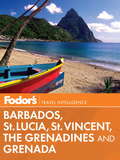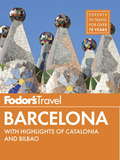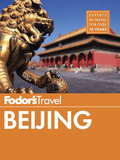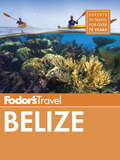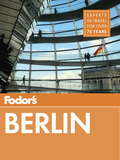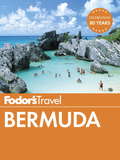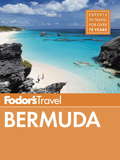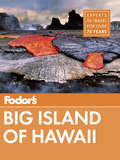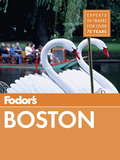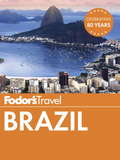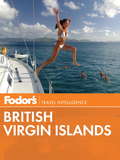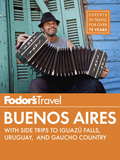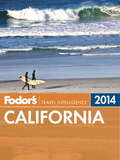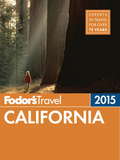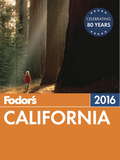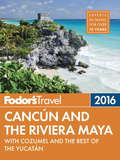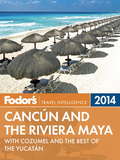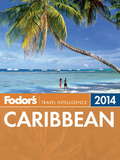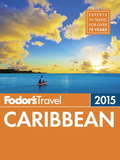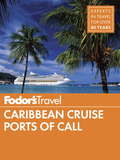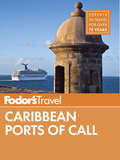- Table View
- List View
Fodor's Barbados, St. Lucia, St. Vincent, the Grenadines & Grenada
by Fodor'sGet inspired and plan your next trip with Fodor's ebook travel guide to Barbados, St. Lucia, St. Vincent, the Grenadines, and Grenada. Easy navigation makes it simple for you to move through each section of the ebook with a simple touch. To get your bearings, browse a brief overview and peruse full-color maps of the islands. You'll immediately develop a sense of each island's awe-inspiring beauty as you flip through a vivid full-color photo. Read more about the islands and find all of the essential, up-to-date details you expect in a Fodor's guide: From the best dining and lodging to top beaches and attractions, Fodor's has it all. Discover five great Caribbean islands in one ebook. There's always something to do in Barbados, with its soft, white-sand beaches, welcoming hotels and resorts, sophisticated dining, and exciting nightspots. St. Lucia's calm cobalt-blue waters make for some of the best off-the-beach snorkeling in the Caribbean. The dark volcanic-sand beaches on St. Vincent and the Grenadines' excellent waters for sailing make these islands a great place to relax and get away from it all. Renowned for its natural beauty, fragrant air, and friendly people, Granada has lovely beaches and plenty of outdoor and cultural activities. Fodor's helps you unleash the possibilities of travel with the insightful tools you need to experience the trips you want. Plan your ideal trip armed with the assurance of our expertise, the guarantee of selectivity, and the choice details that define a destination. Note: This ebook edition includes photographs and maps that will appear on black-and-white devices but are optimized for devices that support full-color images.
Fodor's Barcelona
by Fodor'sFodor's correspondents highlight the best of Barcelona, including the medieval Gothic Quarter, Barceloneta's beach life, and Gaudí's distinctive architecture. Our local experts vet every recommendation to ensure you make the most of your time, whether it's your first trip or your fifth. MUST-SEE ATTRACTIONS from the Boqueria market to Park Güell PERFECT HOTELS for every budget BEST RESTAURANTS to satisfy a range of tastes GORGEOUS FEATURES on Spanish wine and the Sagrada Família VALUABLE TIPS on when to go and ways to save INSIDER PERSPECTIVE from local experts COLOR PHOTOS AND MAPS to inspire and guide your trip walk that connects several major monuments. A seven-page illustrated feature on Spanish wine gives travelers a primer on great sips. Spotlights throughout the guide featuring tapas, wine bars, and the city's best beaches give travelers an unparalleled sense of Barcelona. Indispensable Trip Planning Tools: Tips on when to visit each neighborhood and the city's major monuments, how and where to order the best Spanish wine, and which beaches are best for sunbathing versus surfing all help our readers navigate the city. City walk leads travelers from the well-trafficked Rambla to the little gourmet counter of Quim de la Boqueria. Discerning Recommendations: Fodor's Barcelona offers savvy advice and recommendations from local writers to help travelers make the most of their time. Fodor's Choice designates our best picks, from hotels to nightlife. Pullout Map: A handy take-along map provides added value, giving travelers essential information about top attractions, walking tours, and nearby dining so they can travel with confidence. ABOUT FODOR'S AUTHORS: Each Fodor's Travel Guide is researched and written by local experts.
Fodor's Beijing
by Fodor'sFodor's correspondents highlight the best of Beijing, including World Heritage sites, memorable markets, fantastic street food, and world-class nightlife. Our local experts vet every recommendation to ensure you make the most of your time, whether it's your first trip or your fifth. MUST-SEE ATTRACTIONS from the Forbidden City to the Great Wall PERFECT HOTELS for every budget BEST RESTAURANTS to satisfy a range of tastes GORGEOUS FEATURES on Chinese history, food, and architecture VALUABLE TIPS on when to go and ways to save INSIDER PERSPECTIVE from local experts COLOR PHOTOS AND MAPS to inspire and guide your trip). Fodor's on-the spot experts cover it all, as well as which palace-hotels roll out the red carpet for business leaders and which restaurants offer the spice-infused "Imperial Banquet."HELPFUL TRANSLATIONS: Each property is listed with Chinese characters and Pinyin (the official phonetics system for transliteration), as well as its English name, to make navigating the city easier.ILLUSTRATED FEATURES: Full-color, magazine-style features highlight distinctive aspects of Beijing's culture and history, including an illustrated layout of the Forbidden City, the lowdown on Chinese cuisine, and a guide to getting the most out of a visit to the Great Wall.INDISPENSABLE TRIP PLANNING TOOLS: Neighborhood overviews with easy-to-read color maps, top things to do, and tips for getting around help travelers plan their stays. "Best Bets" charts for restaurants and hotels, and features on top attractions, top experiences, fabulous festivals, and what to do with kids help prioritize what to see and do in this fascinating city.DISCERNING RECOMMENDATIONS: Fodor's Beijing offers savvy advice and recommendations from local writers to help travelers make the most of their time. Fodor's Choice designates our best picks, from hotels to nightlife.ABOUT FODOR'S AUTHORS: Each Fodor's travel guide is researched and written by local experts.
Fodor's Belize
by Fodor'sFodor's correspondents highlight the best of Belize, with spectacular diving and snorkeling sites, exotic wildlife, and fascinating Mayan ruins, as well as a side trip to Guatemala's Tikal. Our local experts vet every recommendation to ensure you make the most of your time, whether it's your first trip or your fifth. MUST-SEE ATTRACTIONS from Ambergris Caye to Placencia PERFECT HOTELS for every budget BEST RESTAURANTS to satisfy a range of tastes Useful FEATURES on cuisine and ecotrips VALUABLE TIPS on when to go and ways to save INSIDER PERSPECTIVE from local experts Maps and COLOR PHOTOS to guide and inspire your tripes with maps and recommended outfitters. Choose an adventure, from bird watching to cave tubing to ecotours, from our special Adventure Vacations chapter. And learn about the Mayas with our brief history of the people, tips on visiting the ruins, and a special Maya-ruins itinerary. Discerning Recommendations: Fodor's Belize ebook offers savvy advice and recommendations from local writers to help travelers make the most of their time. Fodor's Choice designates our best picks, from hotels to nightlife. "Word of Mouth" quotes from fellow travelers provide valuable insights. ABOUT FODOR'S AUTHORS: Each Fodor's Travel Guide is researched and written by local experts.
Fodor's Belize: with a Side Trip to Guatemala
by Fodor'S Travel GuidesWritten by locals, Fodor's travel guides have been offering expert advice for all tastes and budgets for more than 80 years. Belize might just have the greatest variety of flora and fauna of any country of its size in the world. Offshore the Belize Barrier Reef, a great wall of coral, stretches the entire 200-mile-length of the coast. And archaeologists have identified more than 600 significant Mayan sites in Belize. Fodor's guide gives you all the information you need to plan the perfect trip, whether you want a scuba adventure, a getaway to a secluded jungle lodge, or barefoot luxury in a peaceful beach town.This travel guide includes:· Dozens of maps· Hundreds of hotel and restaurant recommendations, with Fodor's Choice designating our top picks· Multiple itineraries to explore the top attractions and what’s off the beaten path· Major sights such as Mayan Ruins, Hummingbird Highway and Actun Tunichil Muknal· Side Trip from Belize including Guatemala· Coverage of Belize City, The Cayes and Atolls, Northern Belize, The Cayo, The Southern Coast and The Deep South
Fodor's Berlin
by Fodor'sFodor's correspondents highlight the best of Berlin, including quintessential sights like Checkpoint Charlie, hip neighborhoods, and great spots for currywurst. Our local experts vet every recommendation to ensure you make the most of your time, whether it's your first trip or your fifth. MUST-SEE ATTRACTIONS from art galleries to the Reichstag PERFECT HOTELS for every budget BEST RESTAURANTS to satisfy a range of tastes Useful FEATURES on city itineraries and top festivals VALUABLE TIPS on when to go and ways to save INSIDER PERSPECTIVE from local experts Maps and COLOR PHOTOS to guide and inspire your trip coverage. SPECIAL FEATURES: Special features on top attractions and top experiences, best ways to see the city with kids, Berlin street food trends, a feature on the history and legacy of the Berlin Wall, and a walking tour of the evolving art world will help travelers make the most of their time in this exciting city. ESSENTIAL TRIP-PLANNING TOOLS: Best Bets boxes call out don't-miss restaurants and hotels; easy-to-read neighborhood maps make it easy to scout out the best that Berlin has to offer. Museums and sights are broken down into Top Attractions and Worth Noting, making it easy for travelers to plan their time. DISCERNING RECOMMENDATIONS: Fodor's Berlin offers savvy advice and recommendations from local writers to help travelers make the most of their time. Fodor's Choice designates our best picks, from hotels to nightlife. "Word of Mouth" quotes from fellow travelers provide valuable insights. ABOUT FODOR'S AUTHORS: Each Fodor's Travel Guide is researched and written by local experts.
Fodor's Bermuda
by Fodor'S Travel GuidesBermuda is famous for pink-sand beaches, impossibly blue water, and Kelly-green golf courses, but that's only the beginning. The combination of British old-world charm and modern luxury here presents visitors with an abundance of historic sites, high-end shops, and both chic restaurants and casual beachside eateries, as well as nightlife that's exciting and sophisticated.From the Trade Paperback edition.
Fodor's Bermuda
by Fodor'sFodor's correspondents highlight the best of Bermuda, including historic St. George's, the south shore's stunning beaches, and Hamilton's posh boutiques. Our local experts vet every recommendation to ensure you make the most of your time, whether it's your first trip or your fifth. MUST-SEE ATTRACTIONS from Horseshoe Bay to Front Street PERFECT HOTELS for every budget BEST RESTAURANTS to satisfy a range of tastes Useful FEATURES on golf and Bermudian architecture VALUABLE TIPS on when to go and ways to save INSIDER PERSPECTIVE from local experts Maps and COLOR PHOTOS to guide and inspire your tripncluding the mytsery of its famous triangle, and the allure of its favorite style---Bermuda shorts! ESSENTIAL TRIP-PLANNING TOOLS: A planner gives useful, practical overviews of important travel information. A Calendar of Events helps visitors choose the best time to plan a visit around special festivals, parades, and golf tournaments. Great Itineraries help travelers make the most of their island time. This guide also has useful tips for cruise travelers as well as folks planning Bermuda weddings and honeymoons. DISCERNING RECOMMENDATIONS: Fodor's Bermuda offers savvy advice and recommendations from local writers to help travelers make the most of their time. Fodor's Choice designates our best picks, from hotels to nightlife. "Word of Mouth" quotes from fellow travelers provide valuable insights. ABOUT FODOR'S AUTHORS: Each Fodor's Travel Guide is researched and written by local experts.
Fodor's Big Island of Hawaii
by Fodor'sFodor's correspondents highlight the best of the Big Island, including Hawaii Volcanoes National Park, the beaches of the Kohala Coast, and the scenic Waipio Valley. Our local experts vet every recommendation to ensure you make the most of your time, whether it's your first trip or your fifth. MUST-SEE ATTRACTIONS from Mauna Kea to Hapuna Beach PERFECT HOTELS for every budget BEST RESTAURANTS to satisfy a range of tastes GORGEOUS FEATURES on snorkeling, hula, luau, and lei VALUABLE TIPS on when to go and ways to save INSIDER PERSPECTIVE from local experts COLOR PHOTOS AND MAPS to inspire and guide your tripand snorkelers. DISCERNING RECOMMENDATIONS: Fodor's Big Island offers savvy advice and recommendations from local writers to help travelers make the most of their visit. Fodor's Choice designates our best picks, from hotels to nightlife. "Word of Mouth" quotes from fellow travelers provide valuable insights. ADDED VALUE PULLOUT MAP: A handy take-along Big Island map provides added value. This essential road-trip tool includes inset maps for Kailua-Kona and Hawaii Volcanoes National Park, so visitors can travel with confidence. ABOUT FODOR'S AUTHORS: Each Fodor's Travel Guide is researched and written by local experts.
Fodor's Boston
by Fodor'S Travel GuidesThere's history and culture around every bend in Boston--skyscrapers nestle next to historic hotels while modern marketplaces line the antique cobblestone streets. The city that blends yesterday and today has much to offer, and with this updated Fodor's Gold Guide first-time visitors, as well as returning visitors, will discover all of Beantown's old and new charms.From the Trade Paperback edition.
Fodor's Boston
by Fodor'sFodor's correspondents highlight the best of Boston, including historic landmarks, cultural treasures, Cambridge sights, shopping, and the hottest restaurants on both sides of the Charles River. Our local experts vet every recommendation to ensure you make the most of your time, whether it's your first trip or your fifth. MUST-SEE ATTRACTIONS from Faneuil Hall to Fenway Park Perfect HOtels for every budget BEST RESTAURANTS to satisfy a range of tastes GORGEOUS FEATURES on the Freedom Trail and top museums VALUABLE TIPS on when to go and ways to save INSIDER PERSPECTIVE from local experts COLOR PHOTOS AND MAPS to inspire and guide your tripTop Attractions, Great Itineraries, and Family Favorites features make it easy to plan a vacation. Best bets charts for restaurants and hotels; lists of Freedom Trail sights in each neighborhood; easy-to-read color regional maps; and tips for traveling with kids and frugal fun give useful at-a-glance travel resources. DISCERNING RECOMMENDATIONS: Fodor's Boston offers savvy advice and recommendations from local writers to help travelers make the most of their visit. Fodor's Choice designates our best picks, from hotels to nightlife. "Word of Mouth" quotes from fellow travelers provide valuable insights. ADDED VALUE PULLOUT MAP: A handy take-along Boston map gives travelers essential lay-of-the-land information about top attractions and nearby dining so they can travel with confidence. ABOUT FODOR'S AUTHORS: Each Fodor's Travel Guide is researched and written by local experts.
Fodor's Brazil 2014
by Fodor'sAs host of the 2014 Soccer World Cup and the 2016 Summer Olympics, Brazil promises to be one of the hottest travel destinations in upcoming years. And the country is primed to celebrate. From the picturesque beaches of Rio, to the majestic Iguaçu Falls, to the wonders of the Amazon rainforest, Brazil offers something for every type of traveler--and Fodor's Brazil 2014 ebook covers the best that the country has to offer. Expanded Coverage: This ebook edition includes a new Experience Brazil chapter with in-depth information on Carnival, beaches, and the sounds, tastes, peoples, and wildlife of Brazil. It also works as an expert trip planner, with features on things to do, great itineraries, and when to go. The guide also has expanded coverage of Amazon River cruises, and new restaurants and hotels in the vibrant cities of Rio de Janeiro, Sao Paulo, and Salvador. Indispensible Trip Planning Tools: Convenient overviews show each region and its highlights, and detail-rich chapter planning sections have on-target advice and tips for planning your time and for getting around the country by plane, car, and bus. In addition, creating a tailored trip to Brazil is easy using the "Brazil Planner," "Top Attractions," and "Great Itineraries" in the new Experience chapter. The guide also offers indispensible tips on finding tour operators in the Amazon and the Pantanal. Special Events: Brazil will be in the spotlight in the near future as the host of the 2014 Soccer World Cup and the 2016 Summer Olympics. Fodor's Brazil 2014 ebook contains detailed coverage of the Brazilian cities that will host World Cup games, tips on planning your trip during this tournament, and general information on the importance of soccer in Brazilian culture. Discerning Recommendations:Fodor's Brazil offers savvy advice and recommendations from local writers to help travelers make the most of their time. Fodor's Choice designates our best picks, from hotels to nightlife. "Word of Mouth" quotes from fellow travelers provide valuable insights. ABOUT FODOR'S AUTHORS: Each Fodor's Travel Guide is researched and written by local experts.
Fodor's Brazil 2015
by Fodor'sAs host of the 2016 Summer Olympics, Brazil promises to be one of the hottest travel destinations in upcoming years. And the country is primed to celebrate. From the picturesque beaches of Rio de Janeiro to the majestic Iguaçu Falls to the wonders of the Amazon rainforest, Brazil offers something for every type of traveler--and Fodor's Brazil covers the best that the country has to offer.ural flair of Brazil. * OLYMPIC CONTENT FEATURED ON COVER: The fact that this edition includes a special section on the Rio 2016 Summer Olympic Games, taking place August 5th through August 21st, will be called out on a sticker appering of the front cover of the book. * SPECIAL FEATURES: The Experience Brazil chapter contains in-depth information on Carnival, beaches, and the sounds, tastes, and wildlife of Brazil. It also works as an expert trip planner, with useful features on things to do and Great Itineraries. A standalone section at the back of the book provides helpful Portuguese phrases and pronunciations to guide travelers on their journeys. * INDISPENSABLE TRIP-PLANNING TOOLS: Convenient overviews show each region and its highlights, and detail-rich chapter planning sections have on-target advice and tips for planning your time and for getting around the country by plane, car, and bus. Each chapter opens with a map, Top Reasons to Go and other essential information to help visitors plan time and vacation details effectively. The guide also offers indispensable tips on finding tour operators throughout the country. * SPECIAL EVENTS: Brazil will be in the spotlight as the host of the 2016 Summer Olympics.Fodor's Brazil 7th Edition contains detailed coverage on the venues that will host Olympic events, tips on finding lodging in Rio during the Olympics, and useful information on securing tickets and attending the games. * DISCERNING RECOMMENDATIONS: Fodor's Brazil offers savvy advice and recommendations from local writers to help travelers make the most of their time. Fodor's Choice designates our best picks, from hotels to nightlife. * ABOUT FODOR'S AUTHORS: Each Fodor's Travel Guide is researched and written by local experts.
Fodor's British Virgin Islands
by Fodor'sGet inspired and plan your next trip with Fodor's ebook travel guide to the British Virgin Islands. Easy navigation makes it simple for you to move through each section of the ebook with a simple touch. To get your bearings, browse a brief overview and peruse full-color maps of the islands. You'll immediately develop a sense of the islands' awe-inspiring beauty as you flip through a vivid full-color photo album. Read more about the islands and find all of the essential, up-to-date details you expect in a Fodor's guide: From the best dining and lodging to top beaches and attractions, Fodor's has it all. Discover all of the wonders of the British Virgin Islands in one ebook. These islands are mostly quiet and casual, with soft, white talcum-powder beaches. With more than 60 islands in the chain, laid-back luxury resorts, and great diving and snorkeling at the vibrant reefs a few feet off shore, there's plenty to explore and do. The farther you get from Tortola, the quieter things become. For a truly relaxing experience, be sure to visit the casual beach bars on Jost Van Dyke. Fodor's helps you unleash the possibilities of travel with the insightful tools you need to experience the trips you want. Plan your ideal trip armed with the assurance of our expertise, the guarantee of selectivity, and the choice details that define a destination. Note: This ebook edition includes photographs and maps that will appear on black-and-white devices but are optimized for devices that support full-color images.
Fodor's Brooklyn
by Fodor'sBrooklyn is the most talked about, trendsetting destination in the world, and Fodor's Brooklyn is the only guidebook you need to fully explore New York City's most exciting borough. Written by Brooklynites and illustrated by Brooklyn-based artist Claudia Pearson, this expertly curated guide has a chic design and plenty of savvy advice. Each of the 29 neighborhoods inside is accompanied by a beautiful, easy-to-read map, making it even more fun to explore Williamsburg's art and culinary scene, the amazing views from Brooklyn Heights, or the architecture and greenery of Park Slope. "Best Bet" recommendations list the top places to find great food, shop for Brooklyn-made products, attend cultural events, and more. Notable neighborhood residents have contributed their personal anecdotes about Brooklyn, too, including Borough President Eric L. Adams, founder and chairman of Barnes & Noble, Inc. Leonard Riggio, CEO of the Brooklyn Nets Brett Yormark, founder of Brooklyn Brewery Steve Hindy, actor and filmmaker Adrian Grenier, New York Times Food Editor Sam Sifton, WNYC host Kurt Anderson, and more. Combining artistry with authenticity, Fodor's Brooklyn captures the borough's unique personality--making it the go-to guide for locals and visitors alike. Follow #InsideBklyn to stay in the know and share your own Brooklyn adventures.From the Trade Paperback edition.ight the best of the area. * DISCERNING RECOMMENDATIONS: Fodor's Brooklyn offers savvy advice and recommendations from local writers to help travelers make the most of their visit. Fodor's Choice designates our best picks, from hotels to nightlife. * LOCAL EXPERTS: Fodor's Brooklyn has been researched and written by 11 experts who live in Brooklyn, and a local Brooklyn artist created the illustrations. This new guide also makes use of Fodor's staff knowledge. This is our stomping ground and we're recommending our Brooklyn favorites. If you were our mom, cousin, or best friend coming to visit, this is where we would take you! * OTHER BROOKLYN CONTRIBUTORS: Commentary from other notable Brooklyn insiders is featured throughout the book, including Borough President Eric L. Adams, CEO of the Brooklyn Nets Brett Yormark, co-founder of Brooklyn Brewery Steve Hindy, actor and filmmaker Adrian Grenier, New York Times Dining Editor Sam Sifton, WNYC host Kurt Andersen, and more.
Fodor's Buenos Aires
by Fodor'sFodor's correspondents highlight the best of Buenos Aires, including marvelous museums, sizzling steakhouses, and the hottest spots to dance the tango. Our local experts vet every recommendation to ensure you make the most of your time, whether it's your first trip or your fifth. MUST-SEE ATTRACTIONS from Museo Evita to Plaza de Mayo PERFECT HOTELS for every budget BEST RESTAURANTS to satisfy a range of tastes GORGEOUS FEATURES on gaucho country and Iguazú Falls VALUABLE TIPS on when to go and ways to save INSIDER PERSPECTIVE from local experts COLOR PHOTOS AND MAPS to inspire and guide your trip the most in-depth coverage of the city, Fodor's Buenos Aires gives readers everything they need to plan the trip of a lifetime. Discerning Recommendations: Fodor's Buenos Aires offers savvy advice and recommendations from local writers to help travelers make the most of their visit. Fodor's Choice designates our best picks, from hotels to nightlife. Local Experts: Each Fodor's Travel Guide is researched and written by local experts.
Fodor's California 2013
by Fodor'sCalifornia is one of America's most popular vacation destinations, and for good reason--the state is so diverse that it draws every type of traveler. Fodor's 2013 California ebook covers all corners of the state, from the northern coast to wine country to Los Angeles to the Mojave Desert. Expanded Coverage: New hotels and restaurants are covered around the state, from San Francisco to Lake Tahoe to the Southern Sierra. A revised "What's New in California" section keeps travelers up to speed with exciting new developments.Discerning Recommendations: Fodor's California offers savvy advice and recommendations from local writers to help travelers make the most of their time. Fodor's Choice designates our best picks, from hotels to nightlife. "Word of Mouth" quotes from fellow travelers provide valuable insights.TripAdvisor Reviews: Our experts' hotel selections are reinforced by the latest customer feedback from TripAdvisor. Travelers can book their California stay with confidence, as only the best properties make the cut.
Fodor's California 2015
by Fodor'sFodor's correspondents highlight the best of California, including San Francisco, Napa and Sonoma, Palm Springs, and Yosemite National Park. Our local experts vet every recommendation to ensure you make the most of your time, whether it's your first trip or your fifth. MUST-SEE ATTRACTIONS from Hollywood to Big Sur PERFECT HOTELS for every budget BEST RESTAURANTS to satisfy a range of tastes GORGEOUS FEATURES on coastal drives, wine, and Lake Tahoe VALUABLE TIPS on when to go and ways to save INSIDER PERSPECTIVE from local experts COLOR PHOTOS AND MAPS to inspire and guide your trip technique, and describes how grapes are grown, harvested, and pressed. INDISPENSABLE TRIP PLANNING TOOLS: More than 90 colorful maps guide travelers around the state, plus a pull-out map provides an overview in addition to San Francisco and Los Angeles detail maps. "Top Attractions" and "Top Experiences" help readers choose activities based on their interests, while "Best Bets" for dining and lodging in San Diego, Los Angeles, and San Francisco help them find the next great meal or hotel. For outdoorsy types, the handy Tahoe ski resort chart is great for picking the best slope. In addition, dedicated national parks chapters include planning tips and highlights. DISCERNING RECOMMENDATIONS: Fodor's California offers savvy advice and recommendations from local writers to help travelers make the most of their time. Fodor's Choice designates our best picks, from hotels to nightlife. PULLOUT MAP: A handy take-along map provides added value, giving travelers essential information about top attractions and nearby dining so they can travel with confidence. INCLUDES: San Francisco, Los Angeles, San Diego, Palm Springs, Yosemite National Park, Big Sur, Napa and Sonoma, Monterey Bay, Lake Tahoe, Mendocino, and more. ABOUT FODOR'S AUTHORS: Each Fodor's Travel Guide is researched and written by local experts.
Fodor's California 2016
by Fodor'sCalifornia is one of America's most popular vacation destinations---its diversity draws every type of traveler, from foodies to families. Fodor's full-color California guide covers all corners of the state, from the northern coast to Wine Country and from Los Angeles to Yosemite National Park. such as San Diego's Balboa Park and the San Diego Zoo, as well as Cable Cars and Chinatown in San Francisco. A must-have for wine buffs is the "Wine Tasting in Napa and Sonoma" feature, which suggests a tasting itinerary, teaches the proper wine tasting technique, and describes how grapes are grown, harvested, and pressed. * INDISPENSABLE TRIP-PLANNING TOOLS: More than 90 colorful maps guide travelers around the state, plus a pull-out map provides an overview in addition to San Francisco and Los Angeles detail maps. Top Attractions and Top Experiences help readers choose activities based on their interests, while Best Bets for dining and lodging in San Diego, Los Angeles, and San Francisco help them find the next great meal or hotel. For outdoorsy types, dedicated national parks chapters include planning tips and highlights. * DISCERNING RECOMMENDATIONS: Fodor's California offers savvy advice and recommendations from local writers to help travelers make the most of their time. Fodor's Choice designates our best picks, from hotels to nightlife. * INCLUDES: San Francisco, Los Angeles, San Diego, Palm Springs, Yosemite National Park, Big Sur, Napa and Sonoma, Monterey Bay, Lake Tahoe, Mendocino, and more. * PULLOUT MAP: A handy take-along map provides added value, giving travelers essential information about top attractions and nearby dining so they can travel with confidence. * ABOUT FODOR'S AUTHORS: Each Fodor's Travel Guide is researched and written by local experts.
Fodor's Cancun & the Riviera Maya 2016
by Fodor'sFodor's correspondents highlight the best of the area, including the Riviera Maya's beaches, Cancún's vibrant nightlife, and Cozumel's brilliant coral reefs. Our local experts vet every recommendation to ensure you make the most of your time, whether it's your first trip or your fifth. MUST-SEE ATTRACTIONS from Isla Mujeres to Tulum PERFECT HOTELS for every budget BEST RESTAURANTS to satisfy a range of tastes GORGEOUS FEATURES on Chichén Itza, diving, and tequila VALUABLE TIPS on when to go and ways to save INSIDER PERSPECTIVE from local experts COLOR PHOTOS AND MAPS to inspire and guide your triprest using the guide's "Top Experiences" and "Great Itineraries" sections; maps that locate Cancún's hottest nightclubs; and tips for families, weddings, and honeymoons. DISCERNING RECOMMENDATIONS: Fodor's Cancun and the Riviera Maya offers savvy advice and recommendations from seasoned updaters to help travelers make the most of their time. Fodor's Choice designates our best picks, from hotels to nightlife. INCLUDES: Cancún, Cozumel, Isla Mujeres, Playa del Carmen, Riviera Maya, Tulum, Chichén Itzá, the Yucatán, and more. ABOUT FODOR'S AUTHORS: Each Fodor's Travel Guide is researched and written by local experts.
Fodor's Cancun and the Riviera Maya 2014
by Fodor'sAs the gateway to the Riviera Maya, Cancun is a thriving beach community and Mexico's most popular tourist destination. Fodor's Cancun and the Riviera Maya ebook illustrates the best beaches, resorts, restaurants, and activities in the region, including Cozumel and the Yucatan.Expanded Coverage: Curated content for the Yucatan Peninsula as well as the best new hotels and restaurants have been added. This new edition also features expanded beach coverage, with "Best For" rankings that help travelers choose the perfect beach.Indispensable Trip Planning Tools: It's easy to plan a vacation for any interest using the guide's Top Experiences and Great Itineraries sections; Best Beaches lists; maps that locate Cancun's hottest nightclubs; and tips for families, weddings, and honeymoons.. Discerning Recommendations: Fodor's Cancun and the Riviera Maya offers savvy advice and recommendations from local writers to help travelers make the most of their time. Fodor's Choice designates our best picks, from hotels to nightlife. "Word of Mouth" quotes from fellow travelers provide valuable insights.Tripadvisor Reviews: Our experts' hotel selections are reinforced by the latest customer feedback from Tripadvisor. Travelers can book their stay with confidence, as only the best properties make the cut.
Fodor's Caribbean 2013
by Fodor'sFodor's Caribbean ebook covers almost 50 destinations in the Caribbean, from the Dominican Republic and Trinidad & Tobago, to Turks & Caicos and even Montserrat. The guide reviews the best each island has to offer, including activities, resorts, restaurants, nightspots, shops, and more. This guide is a complete planning tool that will help travelers put together the perfect trip to an island paradise.Competitive Advantage: Fodor's Caribbean is the only comprehensive, full-color guide to the region that is published and updated annually. Expanded Coverage: The Caribbean is ever-changing, and this edition includes new resorts, restaurants, sports and activity outfitters, and attractions.Discerning Recommendations: Fodor's Caribbean offers savvy advice and recommendations from local writers to help travelers make the most of their time. Fodor's Choice designates our best picks, from hotels to nightlife. "Word of Mouth" quotes from fellow travelers provide valuable insights.TripAdvisor Reviews: Our experts' hotel selections are reinforced by the latest customer feedback from TripAdvisor. Travelers can book their Caribbean stay with confidence, as only the best properties make the cut.
Fodor's Caribbean 2016
by Fodor'sFodor's correspondents highlight the best of the Caribbean, including Anguilla's powdery white beaches, Bonaire's colorful coral reefs, and the scenic beauty of Jamaica's Blue Mountains. Our local experts vet every recommendation to ensure you make the most of your time, whether it's your first trip or your fifth.nt cuisines of the region; dance and music; and activities such as sportfishing, diving and snorkeling, and chartering a yacht. * INDISPENSABLE TRIP-PLANNING TOOLS: An island finder helps travelers choose the perfect Caribbean destination. Each chapter opens with four pages that include an island map, the top reasons to go, and other essential information to help visitors plan their time effectively. * DISCERNING RECOMMENDATIONS: Fodor's Caribbean 2016 offers savvy advice and recommendations from local writers to help travelers make the most of their time. Fodor's Choice designates our best picks, from hotels to nightlife. * INCLUDES: Aruba, Barbados, Cayman Islands, Dominican Republic, Jamaica, Puerto Rico, St. Barth, St. Lucia, St. Martin, Turks & Caicos, US Virgin Islands, and more. * ABOUT FODOR'S AUTHORS: Each Fodor's Travel Guide is researched and written by local experts.
Fodor's Caribbean Cruise Ports of Call
by Fodor'S Travel GuidesWritten by locals, Fodor's travel guides have been offering expert advice for all tastes and budgets for more than 80 years. Packed with information on more than 40 ports of call and a dozen ports of embarkation, Caribbean Cruise Ports of Call is a comprehensive guide to everything from sightseeing information and strategies to help cruisers plan their own shore excursions to some basic information on the cruise-ship experience.This travel guide includes:· Dozens of maps· A "Cruise Primer" with the basics of cruising and "Cruising the Caribbean" with capsule overviews of every major cruise line· Hundreds of hotel and restaurant recommendations, with Fodor's Choice designating our top picks· Covered ports of call: Private Islands; St. John's, Antigua; Oranjestad, Aruba; Bridgetown, Barbados; Belize City, Belize; Bermuda; Kralendijk, Bonaire; Calica (Playa del Carmen), Mexico; Cartagena, Colombia; Colon, Panama; Costa Maya, Mexico; Willemstad, Curacao; Roseau, Dominica; Falmouth, Jamaica; Freeport-Lucaya, Bahamas; Grand Cayman, Cayman Islands; Grand Turk, Turks and Caicos Islands; St. George's, Grenada; Pointe-a-Pitre, Guadeloupe; Key West, Florida; La Romana, Dominican Republic; Fort-de-France, Martinique; Montego Bay, Jamaica; Nassau, Bahamas; Charlestown, Nevis; Ocho Rios, Jamaica; Progreso, Mexico; Puerto Limon, Costa Rica; Roatan, Honduras; Samana (Cayo Levantado), Dominican Republic; San Juan, Puerto Rico; Santo Domingo, Domican Republic; Santo Tomas de Castilla, Guatemala; Gustavia, St. Barthelemy; Fredericksted, St. Croix; Cruz Bay, St. John; Basseterre, St. Kitts; Castries, St. Lucia; Philipsburg, St. Maarten; Charlotte Amalie, St. Thomas; Kingstown, St. Vincent; Road Town, Tortola; and The Valley, Virgin Gorda· Covered ports of embarkation: Baltimore, Maryland; Charleston, South Carolina; Fort Lauderdale, Florida; Galveston, Texas; Houston, Texas; Jacksonville, Florida; Miami, Florida; New Orleans, Louisiana; New York, New York; Port Canaveral, Florida; San Juan, Puerto Rico; Tampa, Florida
Fodor's Caribbean Cruise Ports of Call
by Fodor'sPacked with information on more than 40 ports of call and a dozen ports of embarkation, Caribbean Ports of Call ebook edition is a comprehensive guide to everything from sightseeing information and strategies to help cruisers plan their own shore excursions to some basic information on the cruise-ship experience. Expanded Coverage: New attractions and activities are covered in every port along with new lunch recommendations. Many ports of embarkation have new dining and lodging recommendations for cruisers who are embarking in different cities. Indispensable Trip Planning Tools: Every section contains a Best Bets list of activities aimed specifically at cruise passengers, in addition to a well-curated selection of sights and experiences that can be completed in a day in port. A Cruise Primer covers the basics of cruising, while Cruising the Caribbean has capsule overviews of every major cruise line.Competitive Advantage: Unlike other ports of call guides, Fodor's covers the entire Caribbean in one comprehensive volume, as well as a much wider variety of ports of call and ports of embarkation that are dealt with only cursorily in other similar guides.Discerning Recommendations: Fodor's Caribbean Ports of Call offers savvy advice and recommendations from seasoned updates to help travelers make the most of their time. Fodor's Choice designates our best picks, from hotels to nightlife. "Word of Mouth" quotes from fellow travelers provide valuable insights.ABOUT FODOR'S AUTHORS: Each Fodor's Travel Guide is researched and written by local experts.
